Ostankino Tower
Ostankino Tower (Russian: Останкинская телебашня, Ostankinskaya telebashnya) is a television and radio tower in Moscow, Russia, owned by the Moscow branch of unitary enterprise Russian TV and Radio Broadcasting Network. Standing 540.1 metres (1,772 ft), Ostankino was designed by Nikolai Nikitin. It is currently the tallest free-standing structure in Europe and 11th tallest in the world. Between 1967 and 1974, it was the tallest in the world. The tower was the first free-standing structure to exceed 500 m (1,600 ft) in height. Ostankino was built to mark the 50th anniversary of the October Revolution. It is named after the surrounding Ostankino district of Moscow.[4][5]
| Ostankino Tower | |
|---|---|
Останкинская телебашня | |
Ostankino Tower in May 2015 | |
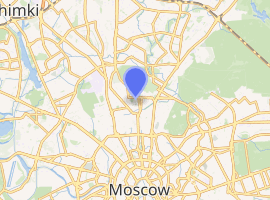
Location in Moscow | |
| Record height | |
| Tallest in the world from 1967 to 1974[I] | |
| Preceded by | Empire State Building |
| Surpassed by | CN Tower |
| General information | |
| Status | Complete |
| Type | Observation, telecommunications, tourism |
| Location | Moscow, Russia |
| Coordinates | 55°49′11″N 37°36′42″E |
| Construction started | 1963 |
| Completed | 1967 |
| Owner | unitary enterprise Russian Television and Radio Broadcasting Network |
| Height | |
| Antenna spire | 540.1 m (1,772.0 ft) |
| Roof | 385.4 m (1,264.4 ft) |
| Top floor | 360.4 m (1,182.4 ft) |
| Technical details | |
| Floor count | 120 (equivalent) |
| Floor area | 15,000 m2 (160,000 sq ft) |
| Lifts/elevators | 11[1] |
| Design and construction | |
| Structural engineer | Nikolai Nikitin |
| References | |
| [2][3] | |
Construction began in 1963 and was completed in 1967. Extensive use of prestressed concrete resulted in a simple and sturdy structure. It surpassed the Empire State Building to become the tallest free-standing structure in the world. It held this record for eight years until it was overtaken by the CN Tower in Canada in 1975, which surpassed its height by 13 metres (43 ft).[6] The Ostankino Tower remained the second-tallest free-standing structure in the world for another 32 years until the Burj Khalifa surpassed both it and the CN Tower in height in 2007. The Ostankino Tower has remained the tallest structure in Europe for over 50 years.
A 1994 plan to increase the tower's height to 561 metres (1,841 ft) by adding an antenna was not implemented for lack of funding.[7]
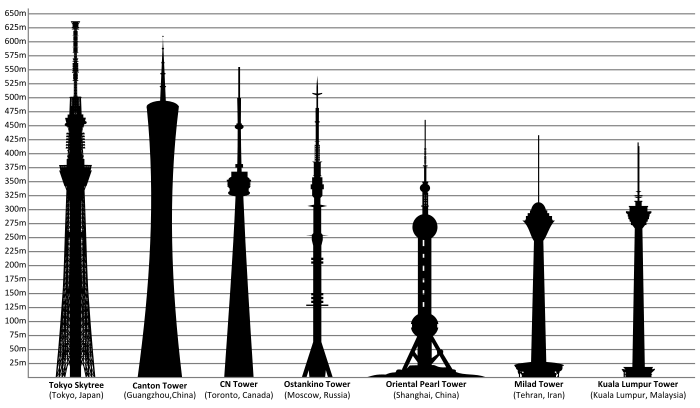
Transmissions
TV stations
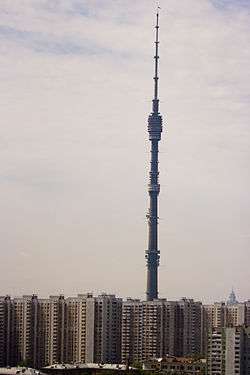
.jpg)
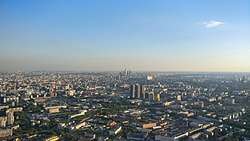
On 15 April 2019 12:00 UTC+3 all analog TV channels were turned off. This table is for historical reasons only.
| Station | Channel | Frequency | ERP |
|---|---|---|---|
| Channel One | 1 | MHz | 40 kW |
| TV Tsentr | 3 | MHz | 40 kW |
| Match TV | 6 | MHz | 1 kW |
| NTV | 8 | MHz | 40 kW |
| Russia 1 | 11 | MHz | 60 kW |
| Che | 23 | MHz | 10 kW |
| 360* Podmoskove | 25 | MHz | 10 kW |
| STS-Moscow | 27 | MHz | 5 kW |
| Disney Channel (Russia) | 29 | MHz | 10 kW |
| Domashniy | 31 | MHz | 20 kW |
| Russia K | 33 | MHz | 20 kW |
| TNT | 35 | MHz | 5 kW |
| Channel Five | 44 | MHz | 5 kW |
| TV-3 | 46 | MHz | 10 kW |
| REN TV | 49 | MHz | 20 kW |
| U | 51 | MHz | 20 kW |
| Zvezda | 57 | MHz | 5 kW |
| 2×2 | 60 | MHz | 5 kW |
TV stations (DVB-T2)
| Station | Channel | Frequency | ERP |
|---|---|---|---|
| Second multiplex: (REN-TV, Spas, STS, Domashniy, TV-3, Sport Plus, Zvezda, Mir, TNT, Muz-TV | 24 | 10 kW | |
| First multiplex: (Channel One, Russia 1, Match TV, Russia K, Russia 24, Karusel, NTV, Channel 5, OTR, TV Center) | 30 | 10 kW | |
| ООО «Цифровое ТРВ» (encoded): (DVisionLive, DVisionNews, DVisionSpice, TV1000) | 32 | 1 kW | |
| Third multiplex (special for Moscow and Moscow region):
Lifenews (24 hours), Sport 1 (24 hours), Nash Futbol (encoded), Doverie (0:00-12:00)/Euronews (12:00-0:00), Sport (00:00—06:00)/Boytsovskiy Klub (06:00—12:00)/Moya Planeta (12:00—18:00)/Nauka 2.0 (18:00—00:00), Russkiy Roman (00:00—05:00)/Russkiy Bestseller (05:00—10:00)/Russkiy Detective (10:00—15:00)/Istoriya (15:00—20:00)/Mult (20:00—00:00), Sarafan (00:00—12:00)/Strana (12:00—00:00), Zhivaya Planeta (00:00—06:00)/IQ HD (06:00—09:00)/24 Doc (09:00—12:00)/Techno 24 (12:00—15:00)/Mama (15:00—18:00)/NST (18:00—21:00)/Park Razvlecheniy (21:00—00:00), Dom Kino (01:30—02:30)/Vremya (02:30—04:30)/Telecafe (04:30—06:30)/Muzyka Pervogo (06:30—01:30), 365 dney TV (00:00—02:00)/TNT-Comedy (02:00—04:00)/ Mnogo TV (04:00—06:00)/HD Life (06:00—08:00)/STV (08:00—10:00)/India TV (10:00—12:00)/Boets (12:00—14:00)/Comedia TV (14:00—16:00)/La Minor(16:00—18:00)/Interesnoe TV (18:00—20:00)/Kukhnya TV (20:00—22:00)/Auto Plus (22:00—00:00) |
34 | 10 kW |
FM stations
| Station | Frequency | ERP |
|---|---|---|
| "Radio Russia", "Radio Podmoskovie" (5:00–1:00) | 66.44 MHz | 15.0 kW |
| "Radio Mayak" | 67.22 MHz | 15.0 kW |
| "Radio Yunost" | 68.84 MHz | 15.0 kW |
| "Pi-FM" | 71.30 MHz | 10.0 kW |
| "Orpheus" | 72.14 MHz | 15.0 kW |
| "Radio Radonezh" | 72.92 MHz | 15.0 kW |
| "Echo of Moscow" | 73.82 MHz | 10.0 kW |
| "Business FM" | 87.50 MHz | 5.0 kW |
| "Radio Retro" | 88.30 MHz | 1.0 kW |
| "Echo of Moscow" | 91.20 MHz | 5.0 kW |
| "Culture" | 91.60 MHz | 5.0 kW |
| "Kommersant FM" | 93.60 MHz | 5.0 kW |
| "My family" | 94.80 MHz | 5.0 kW |
| "Rock FM" | 95.20 MHz | 5.0 kW |
| "Vesti FM" | 97.60 MHz | 5.0 kW |
| "Kino FM" | 98.00 MHz | 10.0 kW |
| "Free radio" | 98.40 MHz | 5.0 kW |
| "Orpheus" | 99.20 MHz | 5.0 kW |
| "Finam FM" | 99.60 MHz | 5.0 kW |
| "Classic Radio" | 100.90 MHz | 5.0 kW |
| "Dance FM" | 101.2 MHz | 10.0 kW |
| "Monte Carlo" | 102.10 MHz | 5.0 kW |
| "Radio Maximum" | 103.7 MHz | 10.0 kW |
| "Russian Radio" | 105.70 MHz | 10.0 kW |
| "Europa Plus" | 106.2 MHz | 10.0 kW |
MW stations
None
Accidents
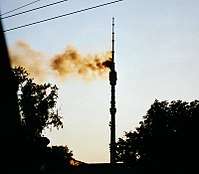
The tower caught fire on 27 August 2000, killing three people. A firefighter and lift operator died when their elevator cabin crashed to the ground level due to the fire. In addition, television and radio signals were disrupted around Moscow. The fire broke out at a height of about 458 m (1,502.6 ft), or approximately 98 metres (322 ft) above the observation platform and the Seventh Heaven restaurant, after a short-circuit in wiring belonging to a paging company.[8] The fire necessitated an evacuation of all visitors and staff from those locations. According to Russian news agencies, the evacuation was complete 90 minutes after the start of the fire. The loss was substantial due to the age and poor maintenance of the electronic equipment, much of which was installed in the 1960s. In addition, the tower had become increasingly packed with equipment.[9]
The failure of the fire suppression systems allowed the fire to destroy most of the tower's interior. Although more than 300 firefighters and other emergency workers were called in, firemen were forced to haul heavy equipment, including chemical fire extinguishers, by hand up the tower to halt the fire. Temporary firewalls of asbestos placed 70 metres (230 ft) up stopped further spread.[8] The fire knocked out virtually all television broadcasts in Moscow and the surrounding regions. The only television station unaffected was the private NTV station, but the government decreed that state channels took priority, and as such, the RTR TV channel began transmitting to several Moscow districts.[10]
The fire caused the tower's upper spire to tilt slightly, triggering fears the tower might collapse. The subsequent inspection determined that although the structure sustained heavy damage, the tower was not in danger of collapse. Efforts began immediately to rebuild the tower, which proved to be a long and expensive task.[11][12]
The fire was the third disaster in Russia in a month, following an explosion in a Moscow underground passage that killed 12 people and the sinking of the submarine Kursk in the Barents Sea, in which 118 died. Russian President Vladimir Putin stated that "This latest accident shows the shape of our vital installations and the overall state of our country. We should not fail to see major problems in the country behind this accident, and we should not forget the economy. Whether or not such accidents happen again in the future will depend on how we work in this vital direction."[13][14]
On 1 July 2004, Australian BASE jumper Christina Grubelnik struck the tower during her descent, receiving a concussion and losing consciousness. Her parachute snagged on a lower-level service platform and she was rescued by Russian emergency services.[15][16][17]
On 25 March 2005 the first new elevators since the August 2000 fire, made by the German company ThyssenKrupp, were tested and put into service. The new elevators travel at a speed of 6 metres per second (20 ft/s).
On 25 May 2007, the Ostankino again caught fire, though it was less serious this time and isolated to a platform on the outside of the tower. All people inside the tower were evacuated and the fire was successfully extinguished, with no casualties.[18]
Activities
In April 2009, the observation platform reopened.[19] The Seventh Heaven restaurant reopened in November 2016.[20]
On 21 July 2018, there was a race up the Tower, which athletes from 12 countries took part in. They ran up the narrow, spiral staircase and reached the location at an altitude of 337.0 meters. The fastest of the 28 athletes were German Christian Riedl, who made it to the top in 9 minutes and 51 seconds. The women's winner was Cynthia Harris (USA), who reached the top in 12 minutes and 15 seconds. Absolute records were then broken into the categories of men and women.[21]
See also
- Ostankino Technical Center
- List of tallest buildings and structures in the world
- List of tallest structures in the former Soviet Union
- List of towers
- Fernsehturm Stuttgart – first TV tower built from concrete and prototype for many similar towers built later
References
- Ostankino Tele Tower at Skyscraperpage.com
- Ostankino Tower at Emporis
- "Ostankino Tower". SkyscraperPage.
- Fire at television tower offers new evidence of Russia's decay, Associated Press (reprinted by the Independent), 28 August 2000. Archived 25 October 2012 at the Wayback Machine
- "Russia's Tallest TV Tower Was Created as Symbol of USSR's Power". Pravda.ru. 21 September 2009. Retrieved 5 October 2009.
- "What if the CN Tower Caught Fire?". CBC News. Canadian Broadcasting Corporation. 10 November 2000. Archived from the original on 13 October 2007. Retrieved 26 June 2007.
- "Ostankino Tower". Emporis Research. Archived from the original on 17 June 2004. Retrieved 7 January 2008.
- Firefighters struggle against a blaze in Moscow television tower by Nick Wadhams, The Independent, 28 August 2000.
- Russian TV knocked out as fire rages through 1,800ft tower by Barry Renfrew, The Independent, 28 August 2000 Archived 25 October 2012 at the Wayback Machine
- Bodies recovered from Moscow TV tower fire. CNN.com, 28 August 2000. Archived 4 June 2011 at the Wayback Machine
- Russia tower fire 'under control', CNN.com, 28 August 2000. Archived 3 May 2010 at the Wayback Machine
- Four feared trapped in burning Moscow tower, CNN.com, 28 August 2000. Archived 3 May 2010 at the Wayback Machine
- Fire in 1,800ft TV tower adds to Russians' feeling of doom by Helen Womackin, The Independent, 29 August 2000. Archived 3 February 2011 at the Wayback Machine
- August, the Cruelest Month by Yuri Zarakhovich, CNN.com. 4 September 2000. Archived 8 July 2007 at the Wayback Machine
- Article about the accident (in Dutch). radio.nl
- Hector Rim (12 March 2012). "moscow tv tower jump accident-Moscú Torre de tv,accidente en salto..wmv". Retrieved 4 October 2018 – via YouTube.
- AP Worldstream (1 July 2004) Austrian parachutist injured, knocked unconscious in jump from Moscow TV tower. www.highbeam.com
- Fire out at Moscow landmark tower. BBC News
- "Московский Региональный Центр : Экскурсии". Retrieved 4 October 2018.
- "В Останкинской башне открылся ресторан "Седьмое небо"". 18 November 2016. Retrieved 4 October 2018.
- "News detail". Retrieved 4 October 2018.
External links
| Wikimedia Commons has media related to Ostankino Tower. |
| Wikinews has related news: |
- Ostankino Television Tower
- A visit to the Ostankino Television Tower at redpenguin.net
- BBC: Moscow's TV tower saved
- Ostankino Tower at Structurae
- Ostankino Tower Above the Clouds at EnglishRussia.com
- Ostankino Tele Tower at Skyscraperpage.com
- Building Tallest Tower at EnglishRussia.com
| Records | ||
|---|---|---|
| Preceded by Empire State Building |
World's tallest free-standing structure 540 m (1772 ft) 1967–1975 |
Succeeded by CN Tower |
